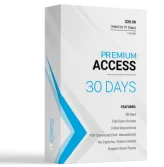Your retail company wants to predict customer churn using historical purchase data stored in BigQuery. The dataset includes customer demographics, purchase history, and a label indicating whether the customer churned or not. You want to build a machine learning model to identify customers at risk of churning. You need to create and train a logistic regression model for predicting customer churn, using the customer_data table with the churned column as the target label. Which BigQuery ML query should you use?
-
A.

------------------------- -
B.

------------------------- -
C.

------------------------- -
D.

-------------------------
Answer : B
Your company has several retail locations. Your company tracks the total number of sales made at each location each day. You want to use SQL to calculate the weekly moving average of sales by location to identify trends for each store. Which query should you use?
-
A.

------------------------- -
B.

------------------------- -
C.

------------------------- -
D.

-------------------------
Answer : C
Your company is building a near real-time streaming pipeline to process JSON telemetry data from small appliances. You need to process messages arriving at a Pub/Sub topic, capitalize letters in the serial number field, and write results to BigQuery. You want to use a managed service and write a minimal amount of code for underlying transformations. What should you do?
- A. Use a Pub/Sub to BigQuery subscription, write results directly to BigQuery, and schedule a transformation query to run every five minutes.
- B. Use a Pub/Sub to Cloud Storage subscription, write a Cloud Run service that is triggered when objects arrive in the bucket, performs the transformations, and writes the results to BigQuery.
- C. Use the “Pub/Sub to BigQuery” Dataflow template with a UDF, and write the results to BigQuery.
- D. Use a Pub/Sub push subscription, write a Cloud Run service that accepts the messages, performs the transformations, and writes the results to BigQuery.
Answer : C
You want to process and load a daily sales CSV file stored in Cloud Storage into BigQuery for downstream reporting. You need to quickly build a scalable data pipeline that transforms the data while providing insights into data quality issues. What should you do?
- A. Create a batch pipeline in Cloud Data Fusion by using a Cloud Storage source and a BigQuery sink.
- B. Load the CSV file as a table in BigQuery, and use scheduled queries to run SQL transformation scripts.
- C. Load the CSV file as a table in BigQuery. Create a batch pipeline in Cloud Data Fusion by using a BigQuery source and sink.
- D. Create a batch pipeline in Dataflow by using the Cloud Storage CSV file to BigQuery batch template.
Answer : A
You manage a Cloud Storage bucket that stores temporary files created during data processing. These temporary files are only needed for seven days, after which they are no longer needed. To reduce storage costs and keep your bucket organized, you want to automatically delete these files once they are older than seven days. What should you do?
- A. Set up a Cloud Scheduler job that invokes a weekly Cloud Run function to delete files older than seven days.
- B. Configure a Cloud Storage lifecycle rule that automatically deletes objects older than seven days.
- C. Develop a batch process using Dataflow that runs weekly and deletes files based on their age.
- D. Create a Cloud Run function that runs daily and deletes files older than seven days.
Answer : B

